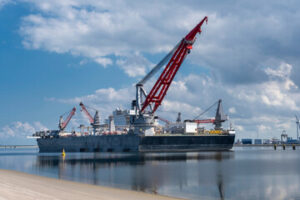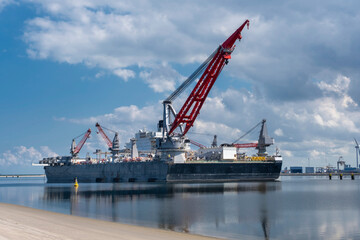Marine Construction Near Me involves the building of structures in large bodies of water, such as ships and piers. It is a complex task that requires the use of advanced tools and technology.
Because marine structures are always in motion, they must follow extra safety standards. Equipment that is damaged, stolen or lost can significantly impact project timelines and productivity.
The shipbuilding industry is one of the most important sectors in the maritime world. It creates a substantial portion of the global economy and is responsible for transporting cargo, passengers, and other goods. Ships also play an essential role in military operations. The process of designing and building ships is complex and requires a lot of time and effort. However, technology has made the task easier and faster. Today, computers can help in the design and manufacturing of naval vessels.
The use of composite materials is a trend in shipbuilding, as it provides advantages over traditional materials. These include lightweight, higher strength, improved corrosion resistance and fatigue performance, and better thermal insulation. In addition, composites can be designed to meet specific application requirements, which helps reduce total system and life cycle costs.
One of the most important aspects of marine construction is safety. Workers face a variety of risks and hazards, including equipment failure, accidents, and injuries. By implementing safety measures, companies can reduce these risks and ensure the health and wellbeing of their employees. In addition, adherence to safety regulations can improve the company’s reputation and reduce legal liabilities.
Another important aspect of marine construction is environmental protection. Due to the nature of their work, companies involved in marine construction must follow strict environmental regulations. This includes documentation procedures and waste management protocols. This helps prevent negative impacts on aquatic ecosystems caused by construction activities.
Because of these unique challenges, it is vital that companies seeking to enter the marine construction industry seek specialized ocean marine insurance coverage. This will protect contractors from exposure to liability claims, which could cost them more than their profit margin. In addition, companies may be required to comply with the Jones Act for vessel crews and federal Longshore and Harbor Workers’ Compensation Act for other workers. By obtaining specialized insurance coverage, these companies can protect themselves from costly liability claims and avoid unnecessary financial losses. By ensuring the health and safety of workers, companies can build a strong reputation in their field and attract more business.
Offshore oil and gas facilities
The offshore oil and gas industry is a significant contributor to global energy production. These facilities enable access to petroleum reserves located beneath the ocean floor, reducing dependence on land-based sources of energy. Offshore drilling and production require large, purpose-built structures to support operations. These structures may be fixed or floating, and must have corrosion-resistant coatings to withstand harsh marine environments.
These structures include drilling rigs, production platforms, and other associated facilities. Drilling rigs are typically constructed on the seafloor and equipped with the necessary equipment to drill oil and gas wells. Some are equipped with heliports, which facilitate the transportation of workers to and from the rig via helicopter. Offshore rigs also contain living quarters for crew members and storage areas for drilling materials.
Once the oil or gas is extracted from a well, it is transported to production platforms. These facilities can range from single-well installations that tie back to an existing platform, to multi-well platforms that connect to a manifold and pipeline system that delivers the gas or oil to nearby shorelines for distribution.
Many marine construction projects involve the installation of these offshore platforms. These projects are often complex and involve the use of large cranes. The resulting environmental impacts can be considerable, and they require careful planning and monitoring. In addition to generating pollution, these activities can disturb the seabed and cause disturbances in marine habitats. Offshore marine contractors have developed a range of mitigation measures that address these issues.
Offshore oil and gas production requires the use of pipelines buried in the seabed or on the surface of the water. These pipelines emit sound and cause vibrations, and they may impact nearby marine mammals. Spills and leaks can occur during construction, operation, and maintenance of oil and gas facilities. They can have varying effects on marine mammals, depending on the type and amount of fluid spilled.
Offshore marine contractors have developed a number of mitigation measures to reduce the impact of oil and gas development on marine mammals. These mitigation measures are implemented throughout project execution. These measures include technical solutions, such as limiting the use of Class 2 and 3 dynamic positioning systems, as well as administrative measures.
Coastal development
In coastal areas, marine civil engineers design and build structures such as sea walls, piers, and docks. They also work with coastal communities to develop sustainable tourism and marine-based energy initiatives. Coastal development requires careful planning to avoid ecological impacts and ensure the safety of workers. This can be achieved by conducting a thorough risk assessment and taking appropriate mitigation measures. The use of innovative technology also helps to streamline the design and construction process. For example, multi-beam surveys enable more accurate underwater mapping prior to and after construction or dredging. This allows engineers to better plan their activities and provides the client with a detailed report of the site condition.
The hazards associated with marine construction include falls, electrical accidents, and exposure to hazardous materials. Several steps can be taken to reduce these risks, including providing training and equipment maintenance, and implementing safety protocols. Having a good safety record also improves the reputation of a marine construction company, which can lead to increased business opportunities.
Another challenge in marine construction is maintaining the integrity of the structure. Unlike land-based buildings, marine structures are exposed to constant water pressure and are subject to abrasion and corrosion. In addition, they may be affected by changes in temperature and salinity levels. Developing and testing new engineering solutions to these challenges is an important part of marine construction.
Coastal regions are essential for the economy, providing critical inputs such as water and space for shipping and ports. In addition, they provide recreational activities such as fishing and diving, and raw materials such as salt and sand. However, the rapid expansion of coastal development has caused environmental concerns, such as erosion, habitat destruction, and pollution. Fortunately, the industry is taking steps to address these issues.
Coastal construction involves working with different laws and regulations, which can be challenging. For example, workers may need to be covered under the Jones Act or the Longshore and Harbor Workers’ Compensation Act. Additionally, contractors may need to obtain a special permit for projects in certain locations. This allows them to comply with local, state, and federal regulations.
Subsea pipelines
Pipelines are an essential part of oil and gas transportation, connecting offshore production equipment to marine transport vessels and onshore processing facilities. The installation and maintenance of subsea pipelines requires specialised engineering skills to ensure their integrity and safety. Failures of submarine pipelines are primarily caused by corrosion, which can result in a loss of oil and gas. These failures can be prevented by using specialised coatings and materials, ensuring that the pipeline is well maintained, and implementing corrosion control programmes.
Subsea pipeline construction begins with planning the route of the pipeline and surveying the seabed for any potential obstacles that could impact on the operation of the pipeline. Once the seabed has been cleared, the pipes are laid in trenches and backfilled to provide stability and protection. Pipelines are typically made of steel with a corrosive resistant coating. Erosion is another key challenge for subsea pipelines, which can be mitigated by the use of specialized materials and by installing flow control devices to reduce the velocity of liquids flowing through the pipeline.
When it comes to designing submarine pipelines, there are several codes and standards that engineers must follow. These codes and standards provide a basis for design, but they are not a substitute for thorough risk assessment and analysis. Some of the most common codes and standards include BS 8010, Offshore Standard OS-F101, API RP-199, and DNV (2000).
The laying of submarine pipelines also requires the use of specialised vessels and equipment. These include anchor handling vessels, towed installations, and towheads, which connect the subsea pipelines with onshore infrastructure. Bundle installations allow for simultaneous installation of multiple components, which can help to reduce project timelines and costs.
The use of diving and ROV operations is another essential aspect of subsea pipeline construction, enabling the execution of a range of inspection, maintenance, and repair tasks. These techniques are vital for reducing the risk of injury to workers and ensuring the quality of their work. In addition to this, effective QSHE management is important for achieving compliance with environmental regulations and ensuring the health and safety of workers.
